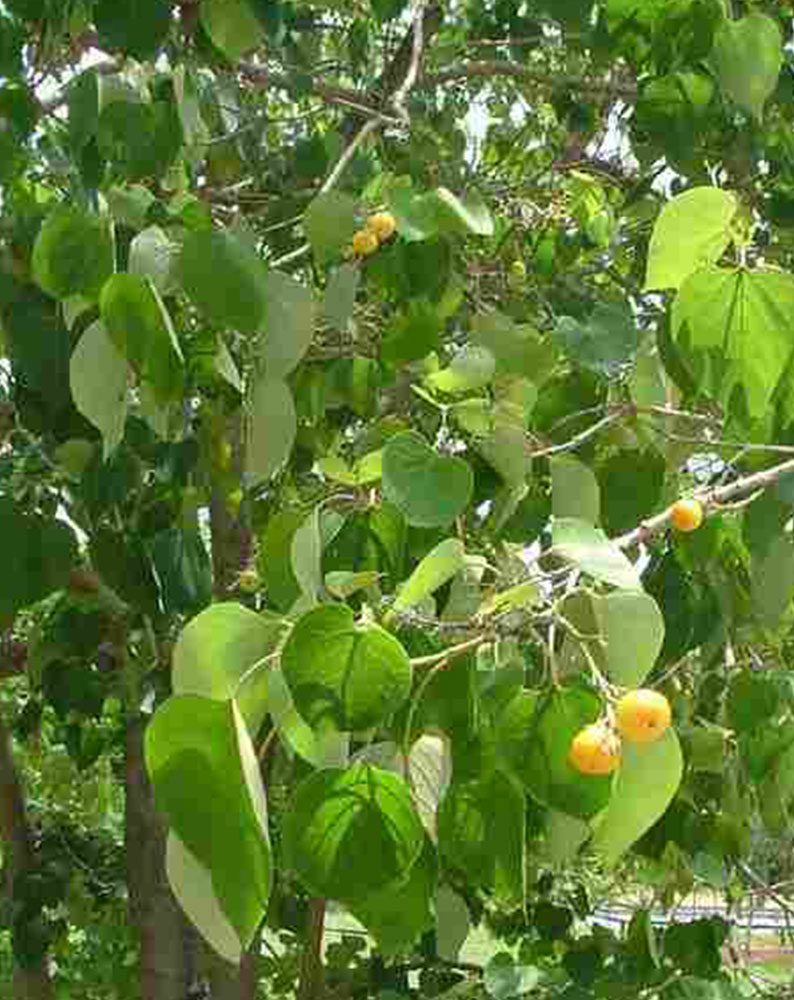Gamhar(Gmelina arborea)
- Family: Lamiaceae
- Local Names: "Ayurvedic name (Gambhari) Hindi name (Gamhar, Khamer, Gambhari, Sewan), English name (Candahar tree, White Teak), Trade name (Gamhar, Gambhari) "
Description
1. It is a moderately deciduous tree with straight trunk and numerous spreading branches, which form large shady crown with whitish grey corky lenticellate bark, exfoliating in thin flakes.
2. It has a clear bole of 6.0-9.0 meter, and a girth 1.5-2.5m. Branchlets and young parts are clothed with fine white mealy pubescence. Leaves are simple, opposite, broadly ovate, cordate, glandular, glabrous above when mature and fulvous-tomentose beneath.
3. It attains its largest dimension in the mixed forests of moist region as in the eastern sub Himalayan track, Assam and elsewhere in south India.
Ecology
1. The species occurs in a variety of forest habitats, including tropical semi-evergreen, sub-montane, very moist teak forests, deciduous, sal and dry teak forests. It also occurs in Syzygium parkland and low alluvial savannah woodland. The tree is a light demander, although it can stand some shade. It is moderately frost hardy and recovers quickly from frost injuries.
2. Gmelina arborea occurs in the western Himalayas. Its choice of site is wide, but it shows a preference for moist fertile valleys with sandy loam soil; in west Bengal, this species grows best on high silt deposits near rivers. It does not thrive where the drainage is poor, while on dry, sandy or otherwise poor soil it remains stunted and is apt to assume little more than a shrubby form because of repeated dying back through drought.
Tree Management
1. Gmelina arborea has suitable characteristics for agroforestry, with fast growth, ease of establishment, and relative freedom from pests outside its natural range (it can be browsed repeatedly without damage). It is an especially promising fuelwood species because it can be established easily, regenerates well from both sprouts and seeds, and is fast growing. Trees coppice well with vigorous shoot growth. Although able to compete with weeds more successfully than many other species, it responds positively to weeding and also benefits from irrigation.
2. Viable seeds should be collected from standing trees of superior phenotype. Seed storage behaviour is orthodox; viability can be maintained for several years in hermetic storage at 3 deg. C with 7-10% mc. On average, there are 1400 seeds/kg.
3. The species occurs in a variety of forest habitats, including tropical semi-evergreen, sub-montane, very moist teak forests, deciduous, sal and dry teak forests. It also occurs in Syzygium parkland and low alluvial savannah woodland. The tree is a light demander, although it can stand some shade. It is moderately frost hardy and recovers quickly from frost injuries.
4. Gmelina arborea occurs in the western Himalayas. Its choice of site is wide, but it shows a preference for moist fertile valleys with sandy loam soil; in west Bengal, this species grows best on high silt deposits near rivers. It does not thrive where the drainage is poor, while on dry, sandy or otherwise poor soil it remains stunted and is apt to assume little more than a shrubby form because of repeated dying back through drought.
5. Normally, seed is collected from the ground, depulped and the stones are dried. Pretreatment is not necessary. For quick germination, the seeds should be soaked for 48 hours. The seeds germinate within 20-50 days under ideal conditions; the average rate for a healthy seed lot is 60%. Trees can be raised easily by transplanting, which is carried out in the rainy season, or by direct sowing in lines; the latter has proved to be more successful in some instances. Large cuttings planted during the rainy season do well.
6. Gmelina arborea is a highly light-demanding species and regenerates naturally only in the open and on the edge of forests. It is an ideal choice for large-scale afforestation programmes.
Timber
When 1st cut, the wood is yellowish- to reddish-white, turning light russet or yellowish-brown with a density of 400-560 kg/cubic m. The wood seasons well without degrading, but it is slow to dry both in the open and in a kiln. Where it is indigenous, it is regarded as a valuable general-purpose wood because of its dimensional stability. The natural durability of the wood is about 15 years. Uses include the manufacture of furniture, plywood core stock, mine props, matches and timber for light construction.
Shade or Shelter
Medicine
Bark, leaves and roots contain traces of alkaloids and are used medicinally in its native range, such as in Hindu medicine. For example, both fruit and bark have medicinal properties against bilious fever.
Gum or Resin


